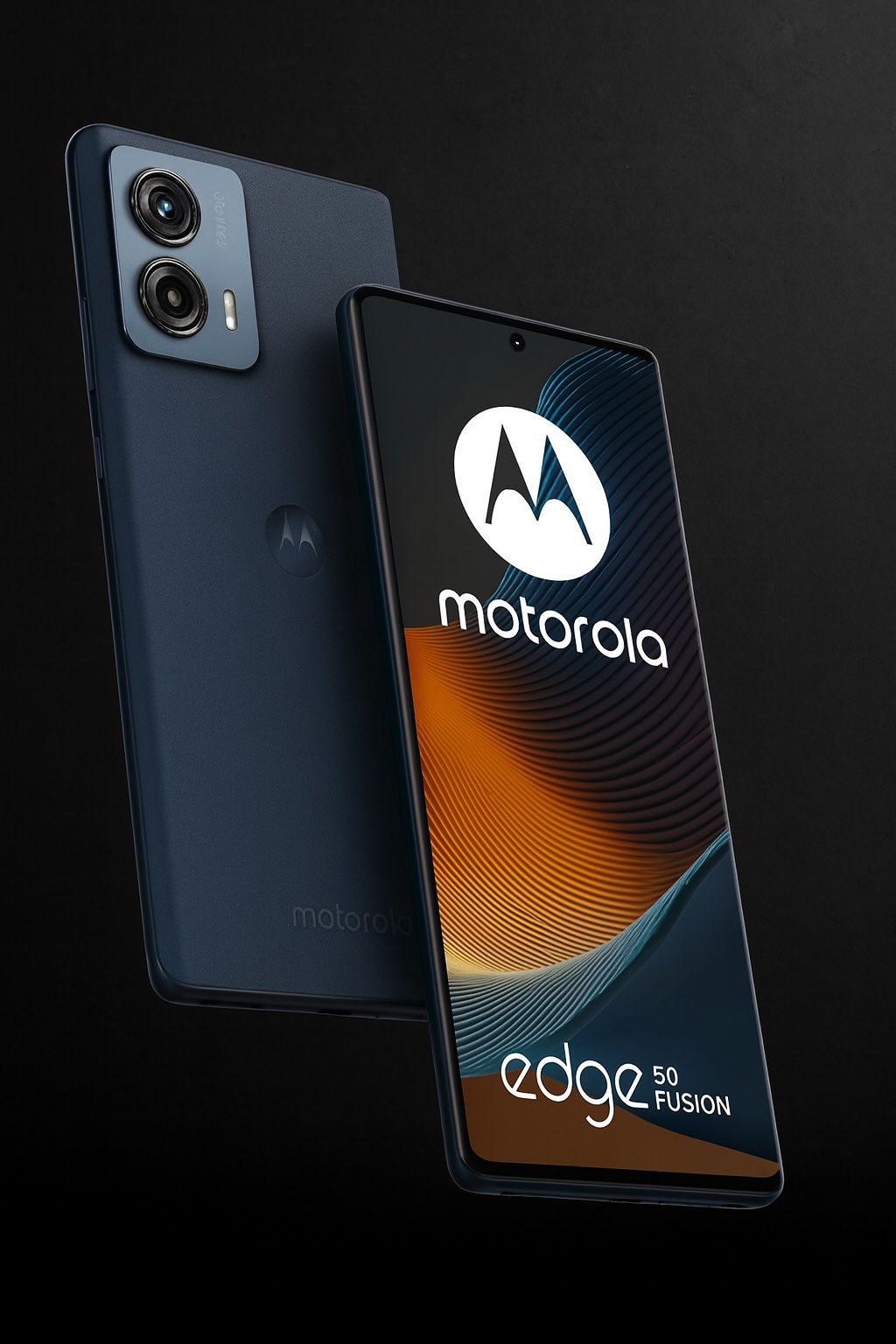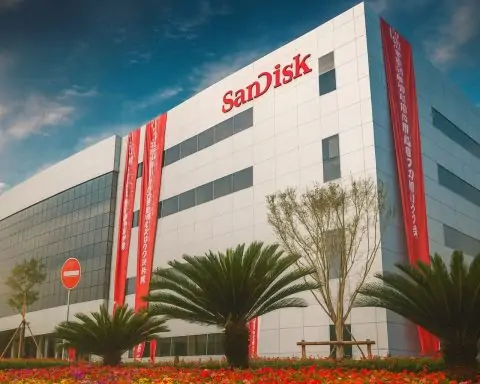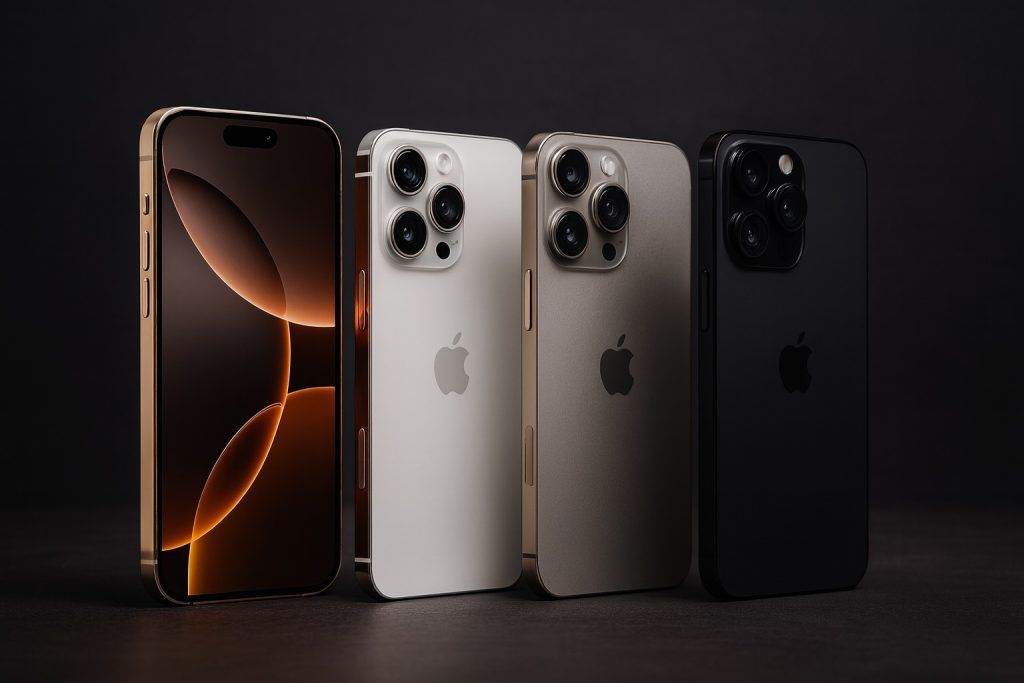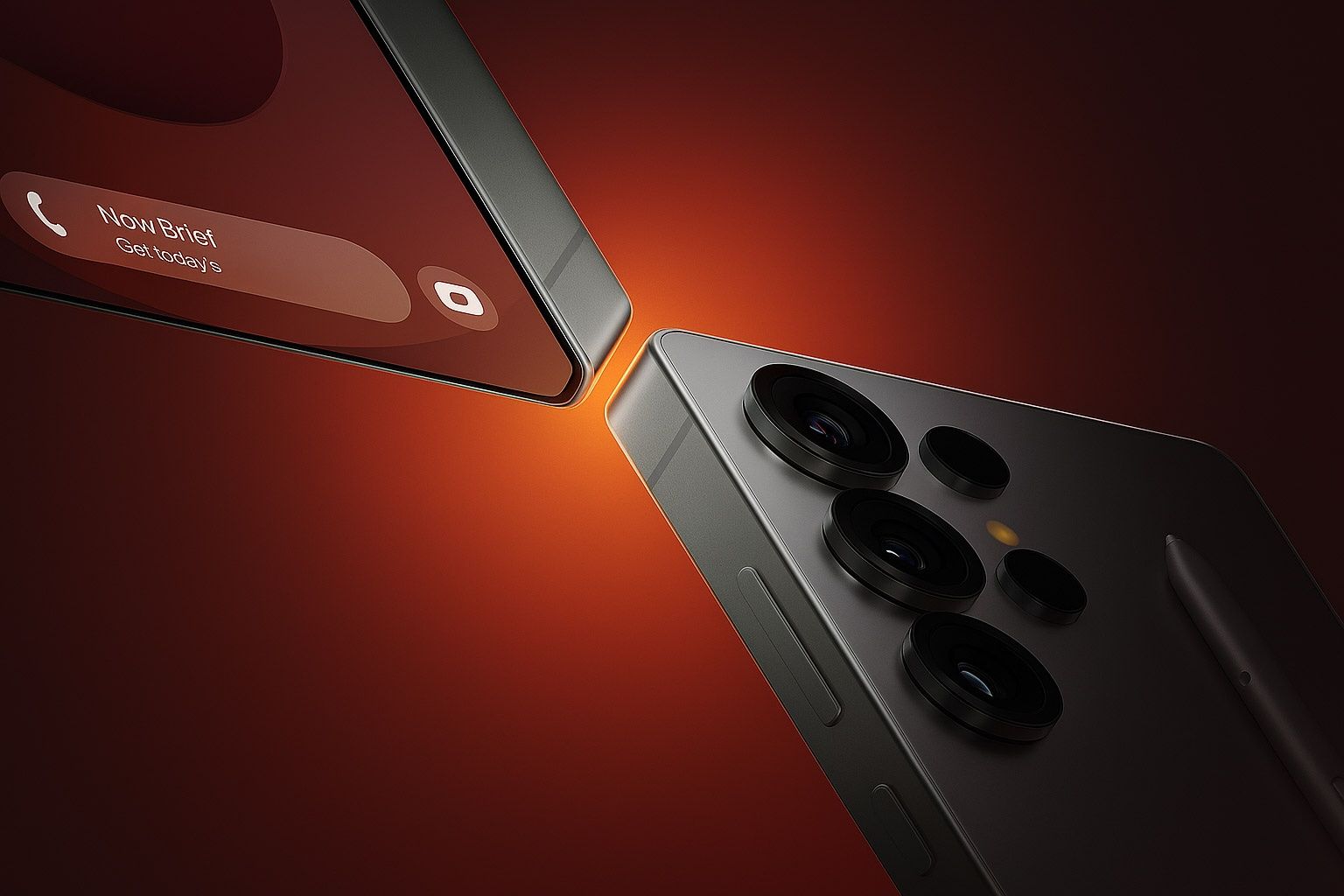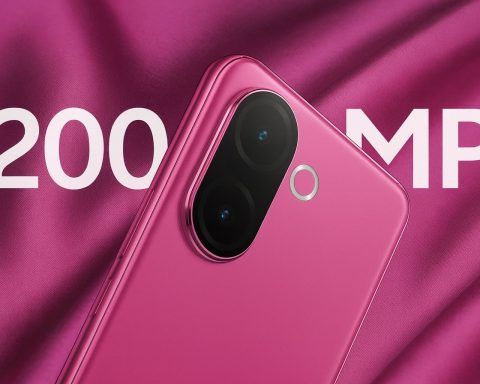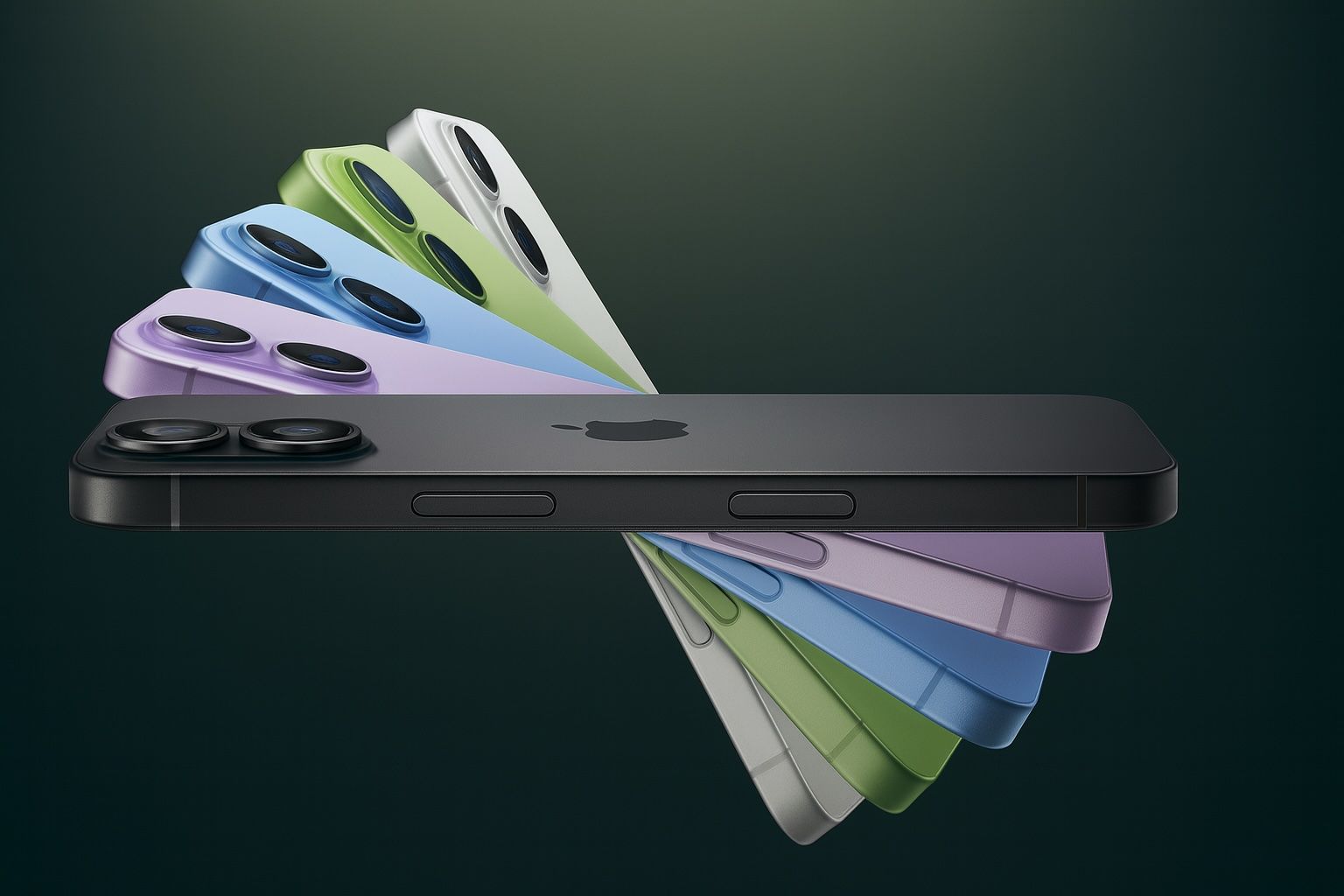Design & Build Quality
- Motorola Edge 50 Fusion: Motorola’s design emphasizes elegance and durability. It features curved “Endless Edge” glass with smooth contours and a seamless camera housing for a premium feel [1]. The phone is impressively slim (7.8 mm) and light (~175 g) [2], offered in eye-catching finishes: Hot Pink vegan suede or Marshmallow Blue vegan leather, and a matte Forest Blue [3]. Despite the stylish looks, it’s tough – the Edge 50 Fusion carries an IP68 rating for water/dust resistance and Gorilla Glass 5 on the display for scratch protection [4]. TechRadar praised its “stylish, high-quality build,” noting the sleek design gives a “premium feel” despite the mid-range price [5].
- Vivo V30 Pro: The V30 Pro also exudes a high-end aura. It’s extremely slim at 7.45 mm and lightweight (188 g) for a phone with a glass back and 5000 mAh battery [6] [7]. The design is minimalist yet elegant, available in colors like Andaman Blue and Classic Black [8], and it incorporates ZEISS branding on the triple-camera module, reflecting its photography focus. It has an IP54 rating, meaning it can survive dust and light splashes [9] – useful, though not as rugged as its Motorola rival. The frame and back are premium glass and metal, which feel smooth and “premium” in hand [10]. Gadgets360 lauded the V30 Pro’s “thin and minimalist design” that gives a very “premium feel” for its class [11].
- Oppo Reno 12: Oppo offers a blend of style and sturdiness. The Reno 12 sports Oppo’s “Quad-Micro Curved” design – a 6.7-inch display with subtly curved edges on all sides for an immersive look [12]. It comes in chic finishes: Sunset Peach and Astro Silver have shimmering effects (with “Fluid Ripple” and graphic crystal processes for a unique look), while Matte Brown provides a subdued, fingerprint-free matte finish [13]. The build uses a plastic frame and back, but Oppo’s design cleverly mimics metal and glass so well “you’d hardly notice without close inspection” [14]. Importantly, the Reno 12 is built to be durable: it features “All-Round Armour” chassis reinforcement with high-strength alloy metals, and is IP65 rated, protecting against dust and low-pressure water jets [15]. (The slightly different Reno 12 FS variant even earned IP64 and was praised for its “premium, durable design” despite the budget price [16].) In short, the Reno 12 looks stylish and feels solid, punching above its weight in build quality [17] [18].
Display
Each phone offers a large, vibrant OLED display with high refresh rate, but there are some differences in resolution and brightness:
- Motorola Edge 50 Fusion: It packs a 6.7-inch pOLED “Endless Edge” display (curved sides) with Full HD+ resolution (2400×1080) and an ultra-smooth 144 Hz refresh rate [19]. Colors are 10-bit with 100% DCI-P3 gamut support, delivering over a billion shades, and the panel can reach 1600 nits peak brightness (1200 nits sustained) for good outdoor visibility [20]. TechRadar found the Fusion’s screen large and enjoyable for media, saying the 6.7-inch 144 Hz pOLED “lets the Fusion go head-to-head with more expensive phones” in terms of smoothness and color depth [21] [22]. While it’s not a QHD or HDR10+ panel, reviewers noted it’s “hard to find fault” at this price point [23] – it remains readable even in bright sunlight with its 1,600-nit peaks [24].
- Vivo V30 Pro: Vivo offers the largest and sharpest display here. The V30 Pro’s screen is a 6.78-inch AMOLED with a higher 1260×2800 resolution (slightly above FHD+, ~452 ppi) [25]. It supports up to 120 Hz refresh rate and is HDR10+ certified [26], giving very vibrant colors and excellent detail. Uniquely, Vivo claims an exceptionally high peak brightness of 2800 nits [27] – one of the brightest around – which ensures great visibility even in harsh direct light (though some reviewers noted colors can wash out at peak brightness) [28] [29]. The display is curved at the edges for a premium look, and overall it’s “absolutely stunning” with smooth scrolling and rich colors [30] [31]. Gadgets360 highlighted the “vibrant curved-edge AMOLED display” as a strong point of the V30 Pro [32]. (One downside: it has a single mono speaker, so sound isn’t stereo [33], but the visual experience is top-notch.)
- Oppo Reno 12: The Reno 12 features a 6.7-inch AMOLED display at Full HD+ (1080×2412, ~394 ppi) with a 120 Hz refresh rate, matching the others in smoothness [34]. In India and global models, the screen is protected by Gorilla Glass 7i (the Pro model gets Victus 2) [35]. Brightness peaks around 1200 nits [36] – lower than the Vivo’s, but still decent for outdoor use. The display is vibrant and fluid; Tech Advisor noted the Reno 12 has a “bright OLED display with 120Hz” that’s impressive for its class [37]. While it sticks to a standard FHD+ resolution, text and images look crisp at this size. Both the base and Pro Reno12 have these 6.7-inch 120Hz panels [38], so you’re getting flagship-like refresh rates. Overall, the Reno 12’s screen delivers smooth visuals and punchy colors that make media and games enjoyable at this mid-range price.
Performance (Chipset, RAM, Storage)
- Motorola Edge 50 Fusion: The Edge 50 Fusion is powered by Qualcomm’s Snapdragon 7s Gen 2 chipset (8-core, 4 nm) [39]. This is a capable upper-midrange SoC – not quite flagship-level, but it handles daily tasks and moderate gaming with ease. It’s paired with 8 GB or 12 GB RAM (LPDDR4X) and 128–256 GB of fast UFS storage [40] [41]. Notably, Motorola also provides a microSD expandable storage slot, unlike the other two phones [42], so you can add extra capacity if needed. In use, the 7s Gen2 chip performs well for social apps, web, and casual games, though it can struggle with heavy 3D gaming or intensive multitasking compared to the Dimensity chip in the Vivo [43] [44]. TechRadar observed that while “processing power could be stronger,” the Fusion “handles daily tasks with ease” and offers excellent value for the price [45] [46]. For most users, Motorola’s tuning (near-stock Android and lightweight apps) keeps the phone feeling snappy in everyday scenarios.
- Vivo V30 Pro: Vivo equipped the V30 Pro with a MediaTek Dimensity 8200 chipset (octa-core 4 nm), which is a performance champ in this trio [47]. In fact, it’s closer to flagship-level: reviewers describe it as having “serious muscle under the hood,” easily handling demanding games and heavy multitasking [48]. The phone comes with 8 GB RAM + 256 GB storage in the base model and up to 12 GB + 512 GB in the top variant [49], using fast LPDDR5X RAM and UFS 3.1 storage [50]. This means speedy app launches and smooth performance even with many apps open. In real-world use, the V30 Pro breezes through tasks – a Reddit tech forum member noted the Dimensity 8200 can handle anything, making it great for mobile gaming or power-users [51] [52]. Benchmarks and reviews show the 8200 outclasses the Snapdragon 7-series in CPU/GPU, so the Vivo is the performance leader here. Thermals are well-managed too (the phone doesn’t get excessively hot during gameplay in tests) [53]. Simply put, if you need raw power, the V30 Pro delivers a flagship-like punch in this comparison.
- Oppo Reno 12: The Reno 12 (global/India version) runs on a MediaTek Dimensity 7300 octa-core SoC (branded “7300-Energy” by Oppo) [54] [55]. This is a modern 6 nm mid-range chip, adequate for smooth daily performance and efficient battery life, though a step below the Vivo’s 8200. Chinese versions of Reno 12 actually use a Dimensity 8250 chip [56], but in practice the performance difference is minor – both are solid mid-range performers. Backed by 8 GB RAM and 256 GB storage in the standard configuration (no microSD slot), the Reno 12 multitasks well and apps load quickly. It even supports memory expansion features in ColorOS to use some storage as virtual RAM. In use, the Reno 12 feels responsive: UI animations at 120Hz are fluid, and everyday apps pose no problem. Gaming is smooth on popular titles at medium settings, though heavy games will run a bit better on the Vivo. TechAdvisor’s review of the similar Reno 12 FS noted “dependable performance” for the price [57] [58]. While it won’t win a spec race against the V30 Pro, the Reno’s chip is power-efficient and more than sufficient for typical users’ needs.
Camera Systems
Rear Cameras:
- Motorola Edge 50 Fusion: The Edge 50 Fusion has a dual rear camera setup: a 50 MP main camera (with an f/1.8 lens, 1.0 µm pixels) and a 13 MP ultra-wide camera (120° field of view) [59]. The main 50 MP sensor (a Sony LYT-700C) features OIS (optical image stabilization), which helps keep shots steady and blur-free [60]. In good lighting, the main camera produces sharp, vibrant images with natural colors – TechRadar found it delivers “consistently sharp and vibrant images, even for users who aren’t seasoned photographers” [61]. The 13 MP ultra-wide doubles as a macro shooter and adds versatility for group shots or landscapes [62]. Its quality is decent though not on par with the main lens (detail and dynamic range are a bit lower) [63]. Notably missing is a telephoto lens – unlike the Vivo, the Moto cannot optically zoom, relying on digital zoom beyond 1× [64]. For video, it can record up to 4K 30fps, and the OIS helps in low-light and video stability. Overall, it’s a capable but modest camera system: great main camera quality for the class, useful ultra-wide, but no optical zoom. TechRadar highlighted that serious mobile photographers might miss the telephoto, but for most users the Fusion’s cameras are “highly capable” for everyday pics [65].
- Vivo V30 Pro: Vivo clearly targets photography enthusiasts. The V30 Pro boasts a triple 50 MP rear camera array co-engineered with ZEISS optics [66]. This includes a 50 MP main camera (Sony IMX920 sensor, f/1.88, with OIS), a 50 MP telephoto portrait lens (2× optical zoom, f/1.85), and a 50 MP ultra-wide camera (f/2.0, 119°) [67]. Having three high-resolution sensors is unusual and impressive at this price. In practice, the main camera captures excellent detail with balanced colors and dynamic range, without heavy overprocessing [68] [69]. The telephoto 50 MP lens provides optical 2× zoom for lossless portraits; reviewers found its quality in daylight to be good, though slightly softer than the main camera due to extra processing [70] [71]. The 50 MP ultra-wide can capture expansive shots, though it shows some color inconsistency and softness compared to the other lenses [72] [73]. Still, all three rear cameras produce usable 12 MP binned photos and even 4K videos (the phone can shoot 4K@60fps on all rear lenses) [74]. In low light, the large sensors and OIS on the main lens help a lot – the V30 Pro can pull in colors and details even in near darkness (vivo’s Aura Light flash and ZEISS night mode filters assist here) [75] [76]. Overall, the V30 Pro is “camera-centric” by design [77]. It’s like a photography studio in your pocket – Gadgets360 even called it “a mid-range camera powerhouse”, praising the useful features and ZEISS portrait effects it brings [78] [79]. If your priority is photography, the Vivo’s versatile triple-50MP system stands out as the most advanced camera setup among these three phones.
- Oppo Reno 12: The Oppo Reno 12 (global) comes with a triple camera setup, though not all lenses are equal. It has a 50 MP main camera (Oppo cites it as a Sony LYT 600 sensor on the base model) [80] [81], accompanied by an 8 MP ultra-wide lens, and a basic 2 MP macro sensor [82]. (Some variants or markets list a second 50MP camera, but in India the base Reno12 uses 50+8+2MP [83], while the Pro gets dual 50s + 8MP ultrawide [84].) The 50 MP primary shooter on Reno 12 takes quality shots in good lighting – it benefits from a large sensor and likely shares DNA with the Reno 12 Pro’s main camera, which reviewers found to produce sharp, vibrant images [85]. However, the supporting cameras are modest: the 8 MP ultra-wide is serviceable for wide landscapes or group photos but captures far less detail than the main lens, and the 2 MP macro is only useful for occasional close-ups in ample light. Notably, the Reno 12 Pro (if considering the series) adds a 50 MP telephoto lens with 2× zoom and OIS [86], but the standard Reno 12 does not have optical zoom. On the plus side, Oppo includes a variety of AI camera features (like AI Scene Enhancement, dual-view video, etc.), and the image processing is tuned for punchy, social-media-ready colors. It can also record 4K video (main lens) and has electronic stabilization for video. In summary, the Reno 12’s camera system is decent but a notch below the other two: its main camera can hold its own, but the secondary lenses are just average. TechAdvisor noted the ultrawide and macro “are average” and clearly where cost-cutting occurred [87]. This setup is fine for casual shooters, but photography buffs will find more to love in the Vivo.
Front Cameras:
All three phones cater well to selfie lovers, with Vivo and Oppo going especially high-res:
- Motorola Edge 50 Fusion: It offers a 32 MP front camera for selfies [88]. This shooter produces detailed selfies in good light and even does decently in low light thanks to pixel-binning. It supports features like portrait mode and can record up to 4K video. TechRadar was impressed by the Fusion’s selfie cam, calling it “a selfie snapper of a quality that many much pricier phones don’t match,” noting it performs well even in dim indoor lighting [89]. There’s no front flash, but screen flash helps in dark environments. While it lacks the eye-popping resolution of Vivo and Oppo’s front cams, 32MP is still plenty – and Motorola’s image processing aims for more natural skin tones and good sharpness.
- Vivo V30 Pro: Vivo leads in sheer specs with a 50 MP autofocus front camera (f/2.0) [90]. This is a standout feature – it’s rare to see such a high-resolution selfie lens with AF outside of flagship devices. The large sensor and autofocus mean you can get very sharp self-portraits and group selfies (it has a wide 92° field of view [91] to fit more people in). The image quality is excellent: selfies come out rich in detail and the camera handles tricky lighting well, maintaining contrast without blowing out backgrounds [92] [93]. In fact, The Times of India noted both V30 models have a 50MP front shooter, underlining Vivo’s push for “50MP selfie camera” as a key selling point [94]. The front camera also supports 4K video and Vivo’s portrait software (including ZEISS portrait bokeh effects and an “Aura Light” soft flash from the rear that can assist even for front shots). For vloggers or selfie enthusiasts, the V30 Pro’s front camera is arguably the best of the trio.
- Oppo Reno 12: The Reno 12 comes with a high-resolution 32 MP selfie camera (the Pro model actually upgrades this to 50MP, matching Oppo’s focus on selfies) [95] [96]. At 32MP, the Reno’s front camera is quite capable – it captures clear and bright selfies. It uses AI beautification and portrait modes that Oppo is known for, and can also do 1080p video for vlogging or video calls. While it lacks autofocus, it has a relatively wide aperture (around f/2.4) and a decent sensor size to gather light. In practice, selfies from the Reno 12 are sharp and vibrant in daylight. In low light, it relies on screen flash and AI noise reduction – results are acceptable, though the lack of AF means you need to keep steady at the optimal distance. Overall, Oppo’s selfie camera is very good for its class (and the 50MP front on the Pro is even better), making the Reno series a strong choice for selfie-centric users. It might not beat Vivo’s detail level, but it’s not far behind in typical usage.
Software & Features
- Motorola Edge 50 Fusion: Runs Android 14 out of the box with Motorola’s MyUX interface, which is essentially a near-stock Android experience [97]. Motorola keeps the software clean and bloat-free; you get an uncluttered UI similar to Pixel phones, with just a few Moto custom features. These include the famous Moto Actions and gestures (chop twice for flashlight, twist for camera, three-finger screenshot, etc.), which TechRadar found actually enhanced usability [98]. MyUX also offers theming options – you can personalize icons, fonts, and colors easily [99]. There’s no heavy skin, so performance stays smooth. Motorola has committed to 3 years of Android OS updates and 4 years of security patches for the Edge 50 Fusion [100]. While this is decent, it’s a bit shorter than some competitors (Samsung offers 4 OS years even on some midrange phones) [101]. Still, in August 2025 the Fusion should be receiving Android 15, with two more major updates to go. Notably, Motorola includes the Ready For feature, allowing PC-like connectivity, and Moto Secure for enhanced privacy controls [102] [103]. The software is a selling point if you prefer a light, fast, and Google-like Android with a few handy additions.
- Vivo V30 Pro: Ships with Funtouch OS 14 on top of Android 14 [104]. Vivo’s skin is feature-rich and customizable, but more heavy-handed than Motorola’s UI. It comes with a fair amount of pre-installed apps and vivo’s own services, though you can uninstall some bloat. Funtouch OS offers extensive theming, always-on display options, and a Multi-Turbo mode for gaming. A highlight is the camera software: thanks to the ZEISS partnership, the V30 Pro has special ZEISS portrait modes (e.g. bokeh styles like Biotar, Sonnar, etc.) and a “ZEISS Natural Color” calibration option for more realistic colors [105] [106]. It also has an Aura Light ring on the back for better night portraits, which can automatically adjust color temperature for natural skin tones [107]. In terms of updates, Vivo typically promises around 2 years of Android version updates for V-series, possibly 3 for Pro models, but it’s not as transparent. (The V30 Pro’s successor V40 Pro runs Android 14 as well, and likely V50 is on Android 15, showing Vivo is keeping up with new versions.) One nice feature: the V30 Pro supports extended RAM, effectively adding 12 GB of virtual RAM on top of the physical, which can help keep more apps in memory [108]. Overall, Funtouch OS on the V30 Pro is all about offering lots of features (from an Ultra Game Mode to Jovi voice assistant) and camera tricks. It may not be as streamlined as Motorola’s Android, but it is polished and has useful additions for those who like to tinker with features.
- Oppo Reno 12: Runs ColorOS 14 based on Android 14 [109]. Oppo’s ColorOS is known for its smooth animations and plethora of features/customization. On the Reno 12, ColorOS 14 brings a “Feature-rich user experience” that Tech Advisor noted was surprisingly robust for a budget-friendly phone [110]. There are customizable always-on displays, detailed privacy controls, and a theming engine. A standout are the AI features Oppo has integrated: the Reno 12 comes with AI-powered tools for media and productivity, such as AI Photo Editor, AI Clear Face (to enhance details in images), AI Writer and AI Recording Summary (which can generate summaries of recorded audio) [111]. These leverage the on-device MediaTek APU 655 to enhance usability [112]. Moreover, Oppo includes niceties like RAM expansion, an Omoji avatar feature, and a comprehensive always-on panel that can show animations or info. The Reno 12 is expected to get at least 2 Android version updates (Oppo typically provides around 2 years of OS updates for Reno series). On the security side, it’s equipped with an in-display fingerprint sensor and supports NFC for Google Pay, etc. [113]. ColorOS is quite smooth on the 120Hz display and offers a good balance of customization and stability. If you enjoy having the latest software tricks – like cloning apps, gesture navigation options, and even “Auto Pixelate” for screenshots – the Reno 12’s software will be satisfying. Just note it might have a few pre-loaded apps (some can be uninstalled). All in all, ColorOS 14 on the Reno 12 is modern, snappy, and “punching above its weight” in terms of features provided at this price [114].
Battery Life & Charging
All three phones have beefy batteries and fast charging, but there are subtle differences:
- Motorola Edge 50 Fusion: It houses a 5,000 mAh battery, which Motorola advertises as “over 30 hours of fuel on a single charge” [115]. In real-world use, the Edge 50 Fusion impresses with longevity – TechRadar found it could almost stretch to two full days for moderate use, noting that six hours of screen time left about 30% battery remaining [116] [117]. Streaming 2 hours of Netflix used only ~8% in their test [118], which is excellent. The Fusion supports TurboPower 68W fast charging, and Motorola includes the 68W charger in the box [119] (a nice perk as some competitors omit chargers now). Charging speed is very good: you get about 50% charge in 15 minutes (with “charge boost” mode on) [120], and a full 0–100% charge takes under 50 minutes [121]. This means a quick 10-minute top-up can easily give you a full day’s use. The phone does not support wireless charging (that’s still uncommon in this mid-range). Overall, the Edge 50 Fusion is battery-focused, offering both endurance and fast top-ups – one of the reasons TechRadar gave it high marks, calling out its “long-lasting battery” and the convenience of the included 68W charger [122] [123].
- Vivo V30 Pro: Despite its slim profile, the V30 Pro also packs a 5,000 mAh battery [124]. Battery life is solid – in a video loop test it lasted 19 hours 10 minutes, a bit better than its predecessor [125]. For most users, this translates to a full day of heavy use or easily 1.5 days of moderate use. Vivo’s optimization plus the efficient 4nm chip help stretch battery life. When you do need to recharge, the V30 Pro’s 80W FlashCharge is extremely fast [126]. Using the included 80W charger, it goes from 0 to ~71% in 30 minutes and 100% in around 60 minutes [127] [128]. That’s slightly slower than the Oppo on paper (which also has 80W), likely because Vivo might charge more conservatively towards full charge to protect battery health. Still, an hour for full charge is great, and a quick 15-minute charge easily gives around 50%+. Like the others, there’s no wireless charging here. Vivo advertises that the battery will retain health for a long duration; in fact, the V30 series claims 4 years of battery lifespan with proper charging, thanks to Vivo’s Battery Health Engine [129]. In summary, the V30 Pro has reliable all-day battery stamina and very fast charging, keeping you free from “range anxiety.” It’s well-suited for power users: even with intensive camera and gaming use, you can fill up quickly and keep going.
- Oppo Reno 12: The Reno 12 also comes with a 5,000 mAh battery standard [130]. One of Oppo’s selling points is longevity – they claim the Reno’s battery can endure extensive use and even after years, maintain good capacity (a “four-year battery durability” claim) [131]. In everyday terms, the Reno 12 easily lasts a full day. The combination of a power-efficient chipset (Dimensity 7300) and Oppo’s optimizations means you can get around 6-7 hours of screen-on time comfortably. Where the Reno 12 shines is charging: it supports 80W SUPERVOOC fast charging, identical to the Pro model [132] [133]. This can top the 5000 mAh cell from 0 to 100% in roughly 30-35 minutes in ideal conditions, which is extremely fast. In fact, from 0 to 50% takes only about 10-12 minutes with the 80W charger. This is a huge convenience – a quick charge while you shower or have coffee can power the phone for many hours. Oppo includes the fast charger in the box as well. Like its rivals, the Reno 12 skips wireless charging (reserved for higher-end models). Tech Advisor was impressed with the Reno 12’s “impressive battery life and fast charging”, noting it punches above its price here [134]. Additionally, Oppo has software features like Battery Guard to prevent overcharging at night. In use, you can trust the Reno 12 to not only last all day but also to refill in a flash when needed – a combination that makes it very practical for busy users.
Pricing & Availability (as of August 2025)
India: All three phones are available in India, though at different price tiers. The Motorola Edge 50 Fusion launched at ₹22,999 for 8GB+128GB and ₹24,999 for the 12GB+256GB model [135]. Over time, it has seen discounts – it’s not uncommon to find it around ₹20–23K online for the base variant now [136] [137], making it a great value. The Vivo V30 Pro is pricier, reflecting its higher-end specs: it starts at ₹41,999 for the 8GB+256GB version, and the 12GB+512GB top model is ₹46,999 [138] [139]. Vivo positioned it as an affordable camera flagship, and it’s sold via Flipkart, Vivo’s e-store, and offline retailers since March 2024. The Oppo Reno 12 (8GB+256GB) launched at ₹32,999 in July 2024 [140] [141]. By August 2025 its price in India has dropped to around ₹21,000–₹23,000 on e-commerce sites [142] [143], which is excellent for what it offers. The Reno 12 Pro, for reference, was ₹36,999 for 12+256GB [144], but the standard Reno 12 is the one closer to Motorola’s segment.
Europe: Motorola released the Edge 50 Fusion in Europe – for example, in the UK it debuted at £349.99 (about €399) [145], and in some EU countries it’s been seen around €339. It’s widely available via Motorola’s official site and retailers, except the U.S. (where Motorola skipped this model). Oppo’s Reno series also sells in parts of Europe and Southeast Asia, but availability can be patchy. The Reno 12 (or its variant) could be found in markets like Southeast Asia, and a related model called Reno 12 FS was launched in some regions at under £300 price points [146]. Tech Advisor called the Reno 12 FS “one of the best sub-£300 phones around”, highlighting its value [147]. Vivo’s V series historically hasn’t had a huge presence in Western Europe; the V30 Pro was mainly targeted at India and Asia. By mid-2025, Vivo had launched the V40 and V50 series in India/Asia, but not in Europe. So European customers might only get the Vivo V30 Pro via import or in select markets (e.g. it’s not officially sold in the UK as of 2025). Vivo tends to focus its X series internationally, while the V series is big in India and some APAC regions.
Southeast Asia & Other Markets: Motorola Edge 50 Fusion rolled out in Asia (e.g. Singapore, Thailand) around mid-2024 and should be available through Lenovo/Moto partners. Vivo V30 Pro has been on sale in markets like Malaysia, Indonesia, etc., typically around the equivalent of $500 USD for the base model [148]. Oppo Reno 12 being part of a globally popular line is sold across Asia; by now the Reno 13 series might have replaced it on shelves, meaning you can find Reno 12 at discounted rates. For instance, in markets like the Philippines or Vietnam, Reno 12 5G (8+256) might be roughly around $300-$350 after price cuts. All three brands often offer bank cashback or bundle deals in India/SEA – for example, Oppo gave ₹3,000 cashback offers during launch [149] [150], and Vivo had bank discounts on launch. It’s worth checking current promotions.
In summary, Motorola’s Edge 50 Fusion is the most budget-friendly of the trio (around ₹20–25k or $300), Oppo’s Reno 12 sits in the mid ₹25–30k range (though street prices have fallen) and Vivo V30 Pro is the premium option (₹40k+ ~$500). Each targets a slightly different segment, which is also reflected in their features and performance. All are available in key markets as of August 2025, with successors either released or on the horizon (more on that next).
Successors and Upcoming Models
Each of these smartphones has seen follow-ups or at least rumors of next-gen models, given the fast product cycles in 2024–2025:
- Motorola Edge 50 Fusion → Edge 60 Series: Motorola didn’t stop at the Edge 50 series. In fact, by April 2025, Motorola unveiled the Edge 60 Fusion and was preparing to launch the Edge 60 and Edge 60 Pro globally [151] [152]. Leaked details show the Edge 60 (the direct successor to the Fusion) will step up with a triple camera system (50 MP main + 50 MP + 10 MP telephoto) and a larger 5,500 mAh battery, while retaining a similar 6.67-inch OLED curved display (2712×1220 resolution) [153] [154]. It’s likely to use a newer MediaTek Dimensity 7400 or similar chip in some markets (or the Snapdragon 7s/7 Gen3 in others) [155]. Notably, the Edge 60 series focuses on robustness too – the Edge 60 is expected to carry IP68/IP69 water resistance, making it “remarkably stylish and remarkably robust” [156] [157]. There are even leaks of a Moto Edge 60 Stylus variant in the works, which could add an integrated stylus for productivity users [158]. Looking further, an Edge 70 series leak has already surfaced by mid-2025, suggesting Motorola might accelerate launches [159]. But for now, Edge 50 Fusion owners can look toward the Edge 60 Fusion/Edge 60 as the next upgrade, likely bringing better cameras and incremental performance gains. (Pricing rumors for Edge 60 put it just slightly above the 50 Fusion’s launch price, to maintain its value proposition [160].)
- Vivo V30 Pro → V40 & V50 Series: Vivo has quickly iterated on the V series. In August 2024, Vivo launched the Vivo V40 Pro, which built on the V30 Pro by upgrading to a flagship-class MediaTek Dimensity 9200+ chipset and a larger 5500 mAh battery [161] [162]. The V40 Pro continued the triple 50 MP ZEISS camera system, refining it further, and arrived in markets like India by August 2024 [163]. Fast forward to early 2025, Vivo introduced the Vivo V50. The V50 (launched in India in Feb 2025) came with some substantial changes: a massive 6000 mAh battery with 90W charging, a slightly bigger 6.77-inch 120Hz display, and a dual rear camera system (50 MP main + 50 MP ultra-wide) plus 50 MP selfie camera [164] [165]. It also brought ruggedness to the V series, boasting IP68/69 dust and water resistance (a first for Vivo V phones) [166]. The V50’s pricing started at ₹34,999 for 8+128GB, similar to the V30 Pro’s range [167], but offering a different mix of features (bigger battery, slightly lower camera count). Vivo even planned a V50 “Elite Edition” by May 2025 with design tweaks and spec bumps [168]. Looking ahead, Vivo’s cadence suggests a V60 could appear in 2026, but as of August 2025, the latest news revolves around the V50 series and its variants. For a V30 Pro owner, the V40 Pro was the next logical step (with more power and ZEISS T* lens coating, etc.), and the V50 offers an alternative upgrade focusing on battery and ruggedness [169] [170]. Vivo has shown commitment to the V line, even bringing some X-series flagship tech “downstream” – for instance, the V50 inherited design elements and the curved display from the X-series [171] [172]. So we can expect future V series (V60, etc.) to continue balancing high-end camera features with relatively affordable pricing, making them strong options for photography enthusiasts not looking to pay flagship prices.
- Oppo Reno 12 → Reno 13 and 14 Series: Oppo’s Reno lineup refreshes roughly every 6 months in some regions. The Reno 13 series is already making waves in 2025. Reports suggest the Reno 13 (and Reno 13 Pro) introduced some breakthrough features for the mid-range: for example, the Reno 13 Pro is touted as one of the first in its class with IP69 water resistance (able to survive full submersion and high-pressure water jets) [173]. It also packs a larger 5600 mAh battery, aiming to last beyond two days [174], and continues Oppo’s trend of stylish design with new “urban avant-garde” aesthetics [175]. Early reviews (e.g. Forbes) have called the Reno 13 Pro a “flagship killer” offering long battery life and good cameras in a slim, light package [176]. The standard Reno 13 5G also punches above its weight with a big battery and improved AI features [177]. As for timeline, the Reno 13 family likely debuted in China in early 2025 and is reaching other markets thereafter (possibly under slightly different names or with tweaks). Looking a bit further, rumors about a Reno 14 series suggest Oppo isn’t slowing down – there’s talk that Reno 14 could debut by late 2025 (around July–August) [178]. The Reno 14 is expected to iterate with perhaps a new chipset and camera improvements (possibly Oppo’s 1-inch sensor trickling down?). For someone with a Reno 12, the Reno 13 5G and Reno 13 Pro are the direct successors – they bring refinements like better durability, faster chip (Snapdragon 7+ Gen2 or Dimensity 8300 range), and camera upgrades (the 13 Pro reportedly adds a periscope zoom). Oppo’s strategy is to keep the Reno series at the forefront of mid-range innovation, so each generation gets closer to flagship capabilities. In short, plenty of exciting upgrades are available or coming soon in the Reno lineage – good news if you’re eyeing an upgrade in late 2025, as the Reno 13 and upcoming Reno 14 aim to “shake up the upper mid-range class” [179].
Conclusion & Verdict: Which Phone for Which User?
Choosing among these three excellent phones really depends on your priorities. Here’s a quick verdict for different types of users:
- For Photographers:Vivo V30 Pro is the clear winner. Its triple 50 MP ZEISS-tuned cameras outperform the others by offering a versatile setup (ultra-wide, telephoto, and superb low-light main camera) that yields high-quality shots in almost any scenario [180] [181]. The 50 MP selfie camera is also best-in-class for detailed self-portraits [182]. If you love mobile photography or vlogging, the V30 Pro will delight you with its pro-grade camera features and editing tools. Gadgets360 even dubbed it a “camera-centric smartphone” with useful features like ZEISS Style Portrait bokeh and an aura light for portraits [183] [184]. In comparison, Motorola’s Edge 50 Fusion takes great everyday photos (and has OIS on its 50MP lens [185]) but lacks a telephoto, while Oppo’s Reno 12 has a decent main camera but much more basic secondary lenses [186]. For the most demanding shooters, the Vivo V30 Pro’s imaging prowess and tuning (co-developed with ZEISS) make it the best choice.
- For Mobile Gamers & Power Users:Vivo V30 Pro again takes the crown. Its MediaTek Dimensity 8200 chipset and 12GB RAM option deliver significantly stronger performance than the Snapdragon 7-series in the Moto and the Dimensity 7300 in the Oppo [187] [188]. Gaming at high settings, multitasking between heavy apps, and future-proof performance – the V30 Pro handles it all without breaking a sweat. As one tech review noted, at ₹41,999 you’re getting “serious muscle under the hood” – the 8200 chip built on 4nm can “handle it all” from intense games to productivity tasks [189]. The phone also stays relatively cool and sustains performance well (no major throttling observed in reviews [190]). Motorola’s Edge 50 Fusion is no slouch for everyday use, but its Snapdragon 7s Gen2 may struggle with the most demanding 3D games and won’t get as high frame rates as the Vivo can achieve. The Reno 12’s Dimensity SoC is efficient and fine for casual gaming (and the 120Hz display helps with responsiveness), but it’s not intended for hardcore gamers either. So if you want the fastest phone of these three – whether for gaming, heavy multitasking, or simply keeping your device longer before it feels slow – the Vivo V30 Pro is the best bet. (It also has an advantage of 512GB storage in the top model, great for storing big games and media offline [191].)
- For General Users (everyday use, value for money):Motorola Edge 50 Fusion offers the best all-around value and user experience for most people, especially if budget is a concern. It is the most affordable of the trio yet still delivers a premium design, a gorgeous 144Hz display, ample performance for typical apps, and a clean Android experience that many users find more intuitive [192] [193]. TechRadar’s verdict sums it up well: the Edge 50 Fusion “offers excellent value” for those wanting a reliable, well-featured phone “without paying flagship prices.” [194] You get a long-lasting 5000mAh battery that easily lasts a day or two [195], and the 68W fast charger (included) means quick top-ups [196]. Plus, Motorola’s near-stock Android with a few handy additions (Moto gestures, etc.) makes the phone easy to use and free of bloat, which general users appreciate [197] [198]. Importantly, the Edge 50 Fusion still covers the bases: its cameras are solid for social media shots, the OLED screen is excellent for YouTube/Netflix, and features like stereo speakers and IP68 durability give peace of mind [199]. Unless you specifically need the Vivo’s advanced camera or the Oppo’s extra frills, the Moto provides the smoothest everyday experience per dollar. It’s an ideal choice for the average user who wants a bit of everything (good camera, good battery, good performance) at a comfortable price.
- Honorable Mention – The Stylish All-Rounder: If you’re a general user who prioritizes style and a balanced feature set – and you’re willing to pay a bit more than the Moto – the Oppo Reno 12 is also a strong option. It sits in the middle in cost and in capabilities: you get a premium-looking design with curved display and a slim profile, a bright 120Hz OLED, and very fast 80W charging that makes daily use convenient [200]. Its ColorOS software is feature-rich and the phone includes unique perks like expandable storage via microSD (in some variants) and various AI enhancements [201] [202]. The Reno 12’s cameras are not class-leading, but the main 50MP lens is more than adequate for casual photography and produces nice social-media-ready shots. Essentially, the Reno 12 is a great middle-ground: not as costly as the Vivo, more feature-packed than the Moto in certain aspects (like faster charging, more flamboyant design), and it “combines stylish design, dependable performance, and practical features at an incredible price,” as Tech Advisor noted [203] [204]. It’s one of the best choices if you want a phone that feels premium without a flagship price tag.
Final Verdict: All three phones are excellent in their own right, but cater to slightly different audiences. The Motorola Edge 50 Fusion is the best value and ideal for those who want a fuss-free, durable phone with long battery life and clean software. The Vivo V30 Pro is a powerhouse for photography and performance, perfect for tech enthusiasts, camera lovers, and gamers who can invest a bit more. The Oppo Reno 12 strikes a balance as a fashionable all-rounder, suited for users who want fast charging, a sleek design, and a little taste of everything (design, speed, and decent cameras) in a single device. Each of these “mid-range titans” excels in its own arena, so you really can’t go wrong – it’s about picking the one that aligns with what you value most in a smartphone in 2025.
Sources: Trusted reviews and specs from official sites and tech media were used in this comparison, including Motorola’s and Vivo’s official spec pages [205] [206], launch coverage from reputable outlets like LiveMint [207] [208], India Today [209] [210] and Times of India [211] for pricing, as well as expert reviews from TechRadar [212] [213], Gadgets360 [214] [215], and Tech Advisor [216] [217] that provided in-depth evaluations of each phone.
References
1. www.motorola.com, 2. en.wikipedia.org, 3. www.motorola.com, 4. www.livemint.com, 5. www.techradar.com, 6. www.vivo.com, 7. www.gadgets360.com, 8. timesofindia.indiatimes.com, 9. www.vivo.com, 10. www.reddit.com, 11. www.gadgets360.com, 12. www.indiatoday.in, 13. www.indiatoday.in, 14. www.techadvisor.com, 15. www.indiatoday.in, 16. www.techadvisor.com, 17. www.techadvisor.com, 18. www.techadvisor.com, 19. en.wikipedia.org, 20. en.wikipedia.org, 21. www.techradar.com, 22. www.techradar.com, 23. www.techradar.com, 24. www.techradar.com, 25. www.vivo.com, 26. www.gadgets360.com, 27. www.vivo.com, 28. www.gadgets360.com, 29. www.gadgets360.com, 30. www.reddit.com, 31. www.reddit.com, 32. www.gadgets360.com, 33. www.gadgets360.com, 34. www.gadgets360.com, 35. www.indiatoday.in, 36. www.indiatoday.in, 37. www.techadvisor.com, 38. www.indiatoday.in, 39. en.wikipedia.org, 40. www.livemint.com, 41. www.livemint.com, 42. en.wikipedia.org, 43. www.techradar.com, 44. www.techradar.com, 45. www.techradar.com, 46. www.techradar.com, 47. www.vivo.com, 48. www.reddit.com, 49. techpp.com, 50. www.vivo.com, 51. www.reddit.com, 52. www.reddit.com, 53. www.gadgets360.com, 54. www.indiatoday.in, 55. www.indiatoday.in, 56. www.gadgets360.com, 57. www.techadvisor.com, 58. www.techadvisor.com, 59. en.wikipedia.org, 60. www.techradar.com, 61. www.techradar.com, 62. www.techradar.com, 63. www.techradar.com, 64. www.techradar.com, 65. www.techradar.com, 66. www.vivo.com, 67. www.vivo.com, 68. www.gadgets360.com, 69. www.gadgets360.com, 70. www.gadgets360.com, 71. www.gadgets360.com, 72. www.gadgets360.com, 73. www.gadgets360.com, 74. www.gadgets360.com, 75. www.gadgets360.com, 76. www.gadgets360.com, 77. www.gadgets360.com, 78. www.gadgets360.com, 79. www.gadgets360.com, 80. www.indiatoday.in, 81. www.business-standard.com, 82. www.business-standard.com, 83. www.business-standard.com, 84. www.indiatoday.in, 85. www.indiatoday.in, 86. www.indiatoday.in, 87. www.techadvisor.com, 88. www.amazon.com, 89. www.techradar.com, 90. www.vivo.com, 91. www.vivo.com, 92. www.gadgets360.com, 93. www.gadgets360.com, 94. timesofindia.indiatimes.com, 95. www.business-standard.com, 96. www.indiatoday.in, 97. www.techradar.com, 98. www.techradar.com, 99. www.techradar.com, 100. en.wikipedia.org, 101. www.techradar.com, 102. en.wikipedia.org, 103. en.wikipedia.org, 104. www.vivo.com, 105. www.gadgets360.com, 106. www.gadgets360.com, 107. www.gadgets360.com, 108. www.vivo.com, 109. www.giztop.com, 110. www.techadvisor.com, 111. www.indiatoday.in, 112. www.indiatoday.in, 113. www.gadgets360.com, 114. www.techadvisor.com, 115. www.motorola.com, 116. www.techradar.com, 117. www.techradar.com, 118. www.techradar.com, 119. www.techradar.com, 120. www.motorola.com, 121. www.techradar.com, 122. www.techradar.com, 123. www.techradar.com, 124. www.vivo.com, 125. www.gadgets360.com, 126. www.vivo.com, 127. www.gadgets360.com, 128. www.gadgets360.com, 129. www.indiatoday.in, 130. www.business-standard.com, 131. www.indiatoday.in, 132. www.indiatoday.in, 133. www.business-standard.com, 134. www.techadvisor.com, 135. www.livemint.com, 136. www.amazon.in, 137. www.flipkart.com, 138. techpp.com, 139. timesofindia.indiatimes.com, 140. www.indiatoday.in, 141. www.indiatoday.in, 142. www.gadgets360.com, 143. www.gadgets360.com, 144. www.indiatoday.in, 145. www.techradar.com, 146. www.techadvisor.com, 147. www.techadvisor.com, 148. www.reddit.com, 149. www.business-standard.com, 150. www.business-standard.com, 151. www.phonearena.com, 152. www.phonearena.com, 153. www.phonearena.com, 154. www.phonearena.com, 155. www.phonearena.com, 156. www.phonearena.com, 157. www.phonearena.com, 158. tech.yahoo.com, 159. www.androidheadlines.com, 160. www.phonearena.com, 161. techweez.com, 162. www.hindustantimes.com, 163. indianexpress.com, 164. economictimes.indiatimes.com, 165. economictimes.indiatimes.com, 166. economictimes.indiatimes.com, 167. economictimes.indiatimes.com, 168. www.hindustantimes.com, 169. economictimes.indiatimes.com, 170. economictimes.indiatimes.com, 171. economictimes.indiatimes.com, 172. economictimes.indiatimes.com, 173. www.forbes.com, 174. www.kakuchopurei.com, 175. www.oppo.com, 176. www.notebookcheck.net, 177. www.kakuchopurei.com, 178. www.livemint.com, 179. www.notebookcheck.net, 180. www.gadgets360.com, 181. www.gadgets360.com, 182. www.vivo.com, 183. www.gadgets360.com, 184. www.gadgets360.com, 185. www.techradar.com, 186. www.business-standard.com, 187. www.reddit.com, 188. www.reddit.com, 189. www.reddit.com, 190. www.gadgets360.com, 191. techpp.com, 192. www.techradar.com, 193. www.techradar.com, 194. www.techradar.com, 195. www.techradar.com, 196. www.techradar.com, 197. www.techradar.com, 198. www.techradar.com, 199. en.wikipedia.org, 200. www.business-standard.com, 201. www.techadvisor.com, 202. www.techadvisor.com, 203. www.techadvisor.com, 204. www.techadvisor.com, 205. en.wikipedia.org, 206. www.vivo.com, 207. www.livemint.com, 208. www.livemint.com, 209. www.indiatoday.in, 210. www.indiatoday.in, 211. timesofindia.indiatimes.com, 212. www.techradar.com, 213. www.techradar.com, 214. www.gadgets360.com, 215. www.gadgets360.com, 216. www.techadvisor.com, 217. www.techadvisor.com
